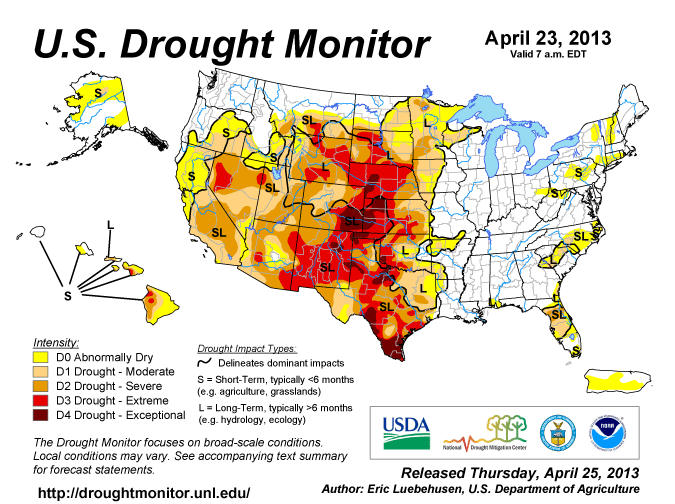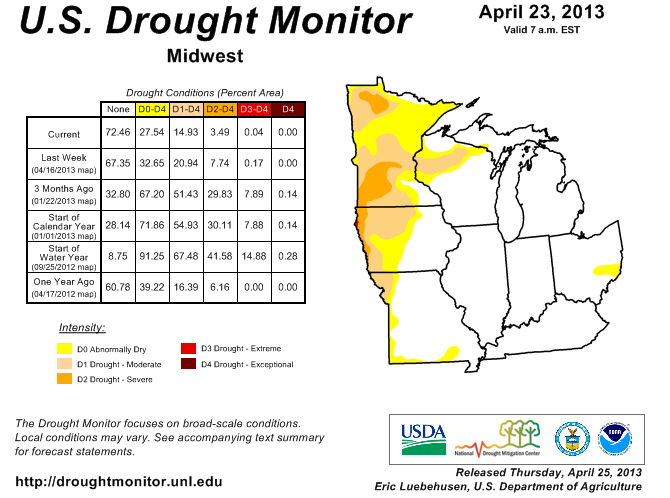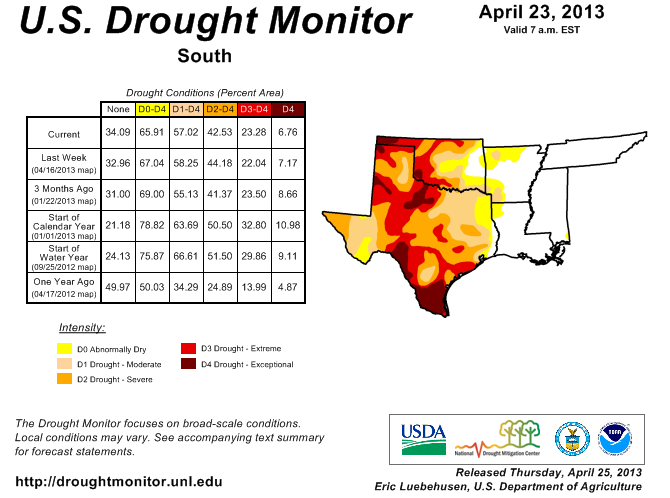Further Drought Improvement Noted Across Midwest

According to the National Drought Monitor, drought coverage deceased from the upper Midwest into the western Corn Belt and central portions of the Rockies and Great Plains, while drought intensified and expanded from western Texas into northern California and the Great Basin. The monitor reflects 60.21% of the nation is still covered by some form of drought, down from 61.67% last week.
For the Midwest, the monitor says heavy rain and wet snow eased long-term drought across western and northern portions of the region. "Liquid-equivalent precipitation of 1 to 3 inches from northern Minnesota into the Upper Peninsula of Michigan eased D0 and D1 (Moderate Drought), as these areas continued to emerge from drought. From southeastern Minnesota into central Iowa, northwestern Missouri and southeastern Nebraska, precipitation totals of 2 to 6 inches resulted in additional, widespread reductions in drought intensity and coverage. However, precipitation totals were somewhat less (1-2 inches) in northwestern Iowa and northeastern Nebraska, where long-term Moderate to Severe (D1 –D2) Drought persisted," it states.
The monitor states that drought intensified over the central High Plains, while heavy rain and wet snow afforded drought relief to eastern portions of the region. "Moderate to heavy rain (2-3 inches) in Kansas eased drought in eastern and north-central portions of the state, with totals approaching 3.50 inches near the Nebraska border. Drought relief largely bypassed central and western Nebraska, although upwards of an inch (liquid equivalent) provided some topsoil moisture near Alliance," it states. "Precipitation totals over the northern Plains’ drought areas ranged from less than an inch in southern Montana to locally more than 2 inches in the Black Hills of South Dakota, where some reductions in drought intensity and coverage were made. Most of the Extreme (D3) or Exceptional (D4) Drought areas received less than 0.50 inch, however, which led to little, if any, change in the worst drought areas. In Colorado, D4 was expanded in the southeastern corner of the state where 90-day precipitation has tallied locally less than 20 percent of normal; the Colorado winter wheat crop was rated 56 percent poor to very poor as of April 21, 2013, while Kansas wheat stood at 37 percent."
Beneficial rain from eastern Texas into the southeastern Plains contrasted with increasing dryness from the upper Rio Grande Valley onto the southern High Plains. "Rainfall totals in northeastern Texas averaged an inch or more from the Dallas-Ft. Worth metro area to Texarkana, which eased Moderate to Severe Drought (D1-D2) in northeastern portions of the state. A swath of locally heavy rainfall (2-5 inches) from the Wichita Mountains in southwestern Oklahoma northeastward through Oklahoma City and Tulsa alleviated Exceptional (D4) to Moderate (D1) Drought, although significant, long-term deficits and impacts continue," it states. "Meanwhile, Moderate (D1) to Exceptional (D4) Drought lingered or intensified from western Texas and southeastern New Mexico into the Oklahoma Panhandle... Precipitation over the past 6 months has totaled less than 40 percent of normal in the worst drought areas, with some stations reporting less than 20 percent of normal."
Looking ahead, the monitor says warmer- and drier-than-normal conditions will spread from the western U.S. eastward into the central and northern Plains. In contrast, a slow-moving, upper-air low will bring wet, cool weather to the Southeast, although rain activity will subside in Florida. "Showers are also expected in central and southwestern Texas; however, the core Exception Drought (D4) areas of the central and southern High Plains will mostly miss the heaviest rainfall. The CPC 6-10 day forecast for April 30 – May 4 calls for warmer- and drier-than-normal weather across much of the west, with dryness extending eastward into the central Plains. In contrast, above-normal precipitation and near- to below-normal temperatures are expected across southern portions of the Rockies and High Plains and from the eastern Gulf Coast into the Great Lakes region," it states.











